The plot began to brew in 2011. For more than fourteen months, the Recreator team dug into fiber market research and technical fabric applications before launching the first line of branded products. We soon realized that more research still needed doing and most universities and fashion brands either didn't know or didn't really care. And so the hands-on hemp adventure continued...
With a little blind faith we invested in experimentation, research and development alongside creating Recreator-branded products to learn both aspects of the supply chain simultaneously and as quickly as possible. Sometimes this meant investing in mistakes and failures, but with them came learning and new relationships.
From growing and harvesting hemp in Colorado beside America’s first modern hemp farmer, Ryan Loflin, to visiting the mills of LA to learn the fundamentals of yarn development and fabric treatments – it has all been massively influential on who we are as a brand, as well as those supporting our vision from day one. See our last piece in the series for an update on our U.S.-grown hemp fiber yarn project – Part III: How To Make It In America.
Hemp Seed – An Agricultural Commodity ... Again
Since the 2018 Farm Bill allowed states to open up commercial hemp farming, we've all heard of hemp fiber growing anywhere and everywhere. While that sounds quite exciting to the wishful, there’s of course far more complication and context for would-be farmers and buyers of this commodity along its transformations, especially when it comes to textile-grade fiber as a finished product.
Although American plant breeders are making ground in producing Association of Official Seed Certifying Agencies (ASOCA) seed, the seed that has been most widely grown in the USA is from imported European or Chinese genetics. On the one hand this has allowed progress with R&D and mild market indicators, yet the importation of foreign genetics may yield a negative impact on the entrepreneurial agricultural needs in true, blue-blooded American markets. Having a world-leading supply network depends on our calculated regional and national interests; today’s work writes tomorrow’s hemp history.
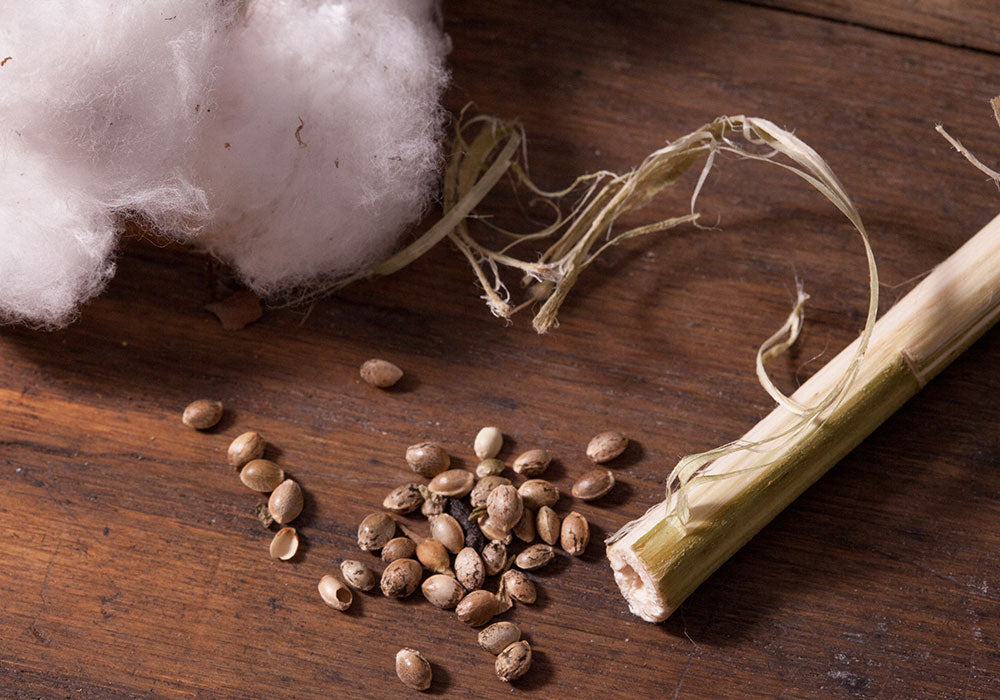 IMG >>> Recreator® raw hemp and organic fibers alongside a Colorado hemp seed variety.
IMG >>> Recreator® raw hemp and organic fibers alongside a Colorado hemp seed variety.
We recommend seeking hemp genetics from similar latitudes and climates around the world using reputable, certified seed distributors and licensed growing consultants. Balancing those standards with the landrace and heirloom genetics processes that have survived the WWII "Hemp for Victory" era is critical. These genetics shouldn’t be further neglected, and all truly should be regarded as national treasures.
Traditionally hemp crops have acclimatized well in most regions, as the cannabis plant species is capable of rapid regional ecosystem resiliency through careful, targeted plant breeding. The genetic flexibility of cannabis is crucial to gradually pairing the best hemp cultivars with their ideal geographies and industrial infrastructure.
Certain varietals are more resilient than others and respond in unique ways to environmental conditions. While considering seeding rates, humidity, average rainfall, soil drainage, elevation, pests, and most certainly the soil’s nutritional qualities, we continue to look to field expertise in best assessing our next fiber trials, starting with the seed.
Hemp is a fairly durable crop, but to produce it consistently for commercial contracts, there is no generic “sow and grow” approach if a producer wants to enter traditional cotton, wool and synthetic fiber markets. Most types of hemp do a relatively good job resisting pests, fungi, wind and weeds, but the variables to tantalize nature's opportunists with other desired treats and organic pest management practices should be thought of symbiotically.
In general, hemp is an annual plant that prefers warm to temperate climates in well-draining soils – those rich in organic matter produce the greatest yields and best quality. Soils low in nitrogen and those in arid, high mountain conditions, can present problems for commercial crops on a few levels. If the seedlings are watered well (but not too much) for the first six weeks or so, the crop's deep tap roots can often help it sustain on most rain fed and otherwise light irrigations ahead in the season.
 IMG >>> Recreator® photo taken in a Springfield, Colorado field nearby the history-making hemp farm at Loflin Farms, operated by farmer Ryan Loflin.
IMG >>> Recreator® photo taken in a Springfield, Colorado field nearby the history-making hemp farm at Loflin Farms, operated by farmer Ryan Loflin.
Geographics –> Choosing Fiber Place
Look, don’t get it twisted – soils love hemp. It is true that hemp can remediate deteriorated soils and bolster soil health with strong tap roots, especially when used as a cover crop and/or in rotations. The crop may aid in sequestering CO2 and expanding our wardrobes with more climate-neutral options, but this does not inherently mean hemp fits into any commercial agriculture model near you as a commodity yet.
Across the country, various regions have an array of unique industrial infrastructure and worker skill sets, as well as ecosystems and environmental challenges to deal with – i.e., erosion control, soil toxicity, salinity, air pollution, wildfires, flooding, carbon output, seed/herbicide relationships, etc. If we’re not making long-term economic decisions collaboratively with Nature, sustainability and regenerative agricultural practices in mind, we miss our mark and great economic opportunity, and worse, we fail farmers by potentially harming their health and the future health of their land.
For textiles, this ideal model looks something like a regional network of dedicated farmers, ranchers, fiber processing and spinning mills on one end, before eventually connecting with skilled designers, cut-and-sew craftspeople, dye houses and brands at the other end – as part of a transparent, digitally traceable supply chain.
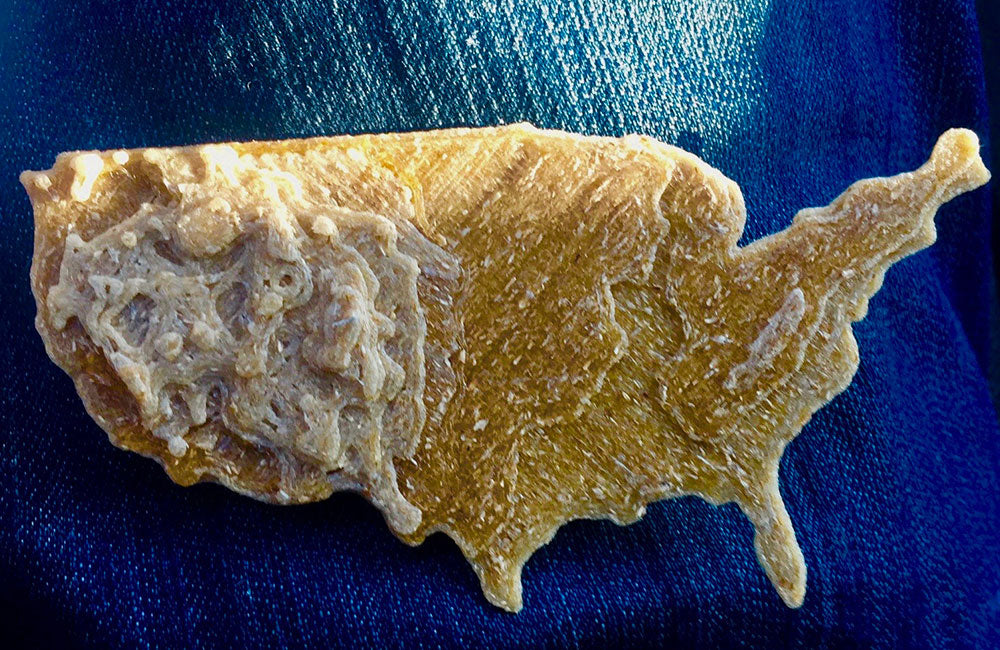 IMG >>> 3D printed hemp plastic production piece from early 2015 using 100% American hemp, partnering with local manufacturers of 3D printers in Loveland, Colorado with hemp grown by New West Genetics in 2015.
IMG >>> 3D printed hemp plastic production piece from early 2015 using 100% American hemp, partnering with local manufacturers of 3D printers in Loveland, Colorado with hemp grown by New West Genetics in 2015.
At Recreator, choosing a location to grow hemp fiber in the USA's infant bast fiber industry is not about large-scale international supply lines or gigantic industrial farms eyeing skyrocketing profits. It’s about lowering carbon costs in shipping logistics and limiting toxic pesticides; it's about growing local biodiversity through sustainable and regenerative agricultural practices; it's about connecting with communities of crafters and buyers of non-toxic, essential goods for living comfortable, conscious and healthy lives.
As every region in America is unique in climate, growing practices, industrial infrastructure and soil type, this results in fiber that might be longer or shorter, more or less heat efficient, fibers that handle moisture differently, some smooth and others with more tensile strength. This could mean one thing for use in hemp plastic bio-composites for cars or hemp insulation for homes, and yet something entirely different in the world of fashion and upholstery.
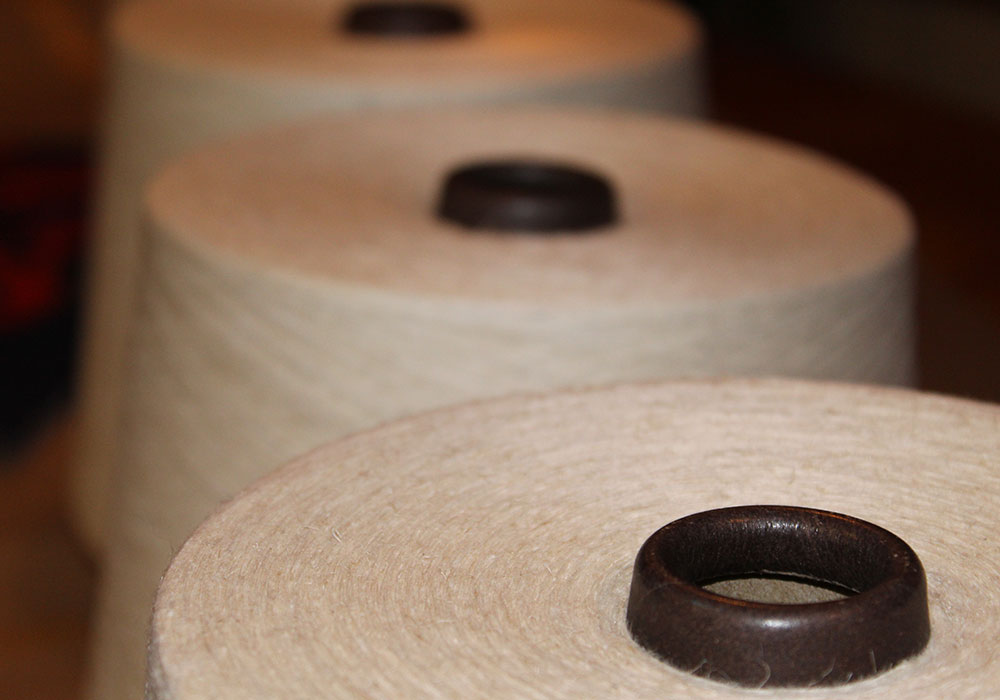 IMG >>> Recreator® Yarn Project – Yarn produced with a fine blend of American-grown hemp and cotton fibers. ( Soil to Stitch TM )
IMG >>> Recreator® Yarn Project – Yarn produced with a fine blend of American-grown hemp and cotton fibers. ( Soil to Stitch TM )
Connecting these economic realities to farming practices that restore soil and local watersheds should be the ideal position for sustainable brands and end market buyers. With the right supply chain transparency models, consumers can know how and where their shirts were grown … and by whom. You could find out if the dye in the shirt is neutral or harms the environment or your health. This vision for a more localized fiber system is what experts are now calling a fibershed – a term coined by author and educator Rebecca Burgess, Founder and Executive Director of the Fibershed non-profit organization.
In her latest book Fibershed: Growing a Movement of Farmers, Fashion Activists, and Makers for a New Textile Economy, she writes, “Similar to a local watershed or foodshed, a fibershed is focused on the source of the raw material, the transparency with which it is converted into clothing, and the connectivity among all parts, from soil to skin and back to soil.”
Knowing Your Place –> Ask Questions:
-
Whose land am I inheriting and what is my responsibility here? What is the geological history of this place (glaciers, volcanoes, grasslands, forests, etc.)? What people and cultures called this place home before I arrived as a steward?
-
What is most needed for this area’s soil and land management when it comes to agriculture? (Consider: freshwater use and conservation; drought or erosion issues contaminated soil; community infrastructure and worker skills; opportunity zone and social impact investments, land grants and tax incentives like carbon buybacks and soil management)
-
What are the major crops and livestock of this region today and in the past 50-100+ years? This investigation should include the time-tested expertise and practices of indigenous peoples and the value of potential landrace and heirloom seed.
-
What kind(s) of fiber is produced in my region (textiles, composites, etc.)? Who are the craftspeople or industries working with plant and/or animal fiber in my region? Can my fiber be integrated into some existing textile process or supply chain? What’s my end market or who is an end user/buyer? How do I build those relationships?
-
Is it legal? What is the regulatory framework in my state and nationwide as fiber crops like hemp enter the free market under the 2018 FARM Bill? Are the seeds AOSCA-certified from a reputable seller – and do those genetics pair with my location and industrial application?
-
How much land will I need for research? For profit? Growing for fiber is far different than growing for CBD. For fiber, research plots can vary but most commercial plots require a minimum of 40 acres.
RECREATOR Fiber in Southern Colorado
Recreator’s first round of research hemp fiber separated for our American Hemp Yarn Project was grown in the mystical San Luis Valley of Southern Colorado. Feeding the headwaters of the Rio Grande, this high-altitude basin of approx. 8,000 sq. miles has an average elevation of 7,600 ft. above sea level with converging mountain ranges everywhere the eye can see.
This rather unknown gem of the American West hosts an incredible range of biodiverse habitats, and resilient peoples, offering prime examples of ecosystem balances, and historical lessons that remind us of the fragility of those “downstream” when natural ecosystems are not stewarded honorably by mans’ “progress.”
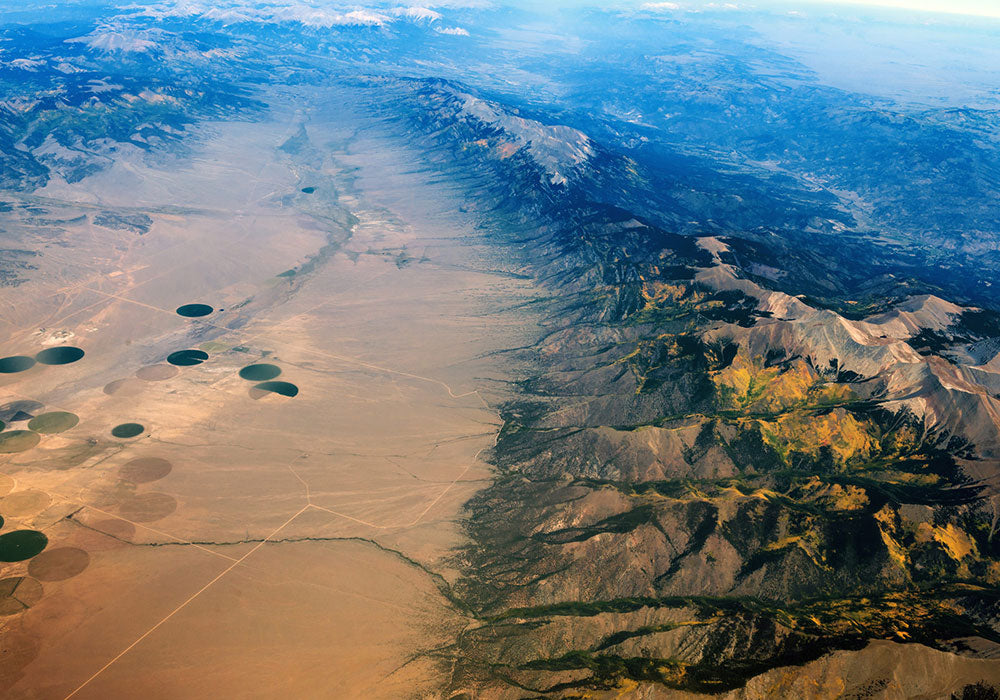 IMG >>> Aerial shot of the San Luis Valley, Colorado. Photo credit: Pavliha (iStock)
IMG >>> Aerial shot of the San Luis Valley, Colorado. Photo credit: Pavliha (iStock)
The original Coloradans were the Ute Indian tribe, but the areas were also widely used by the Navajo, Apache, and Comanche, who came to trade and hunt. Generally the Utes were seasonally nomadic by nature, however, through what little evidence of their cultural materials and practices that remain intact, it’s clear the different bands of the tribe did cultivate food and herbs like corn and wild tobacco. In addition, skin bags and baskets were used to haul items, and clothing was made of woven fibers and leather, to include rabbit skin robes.
By the mid-1800s, the area came to be settled by New Mexico families that were often either farmers, or miners looking for gold and silver – it is also worth noting the area’s mining history indicates that some San Luis Valley (SLV) soils could use the hemp crop more than others to remove toxic heavy metals and restore most productive value to their land.
Because it is a deep alluvial basin, the soil in the SLV also holds a lot of salt and sand leftover from the sea that once filled this vast expanse. The sandy, loam soil and the potential for quick running water means plants benefit from dense seeding to keep soils covered quickly for shade as well – the frequent and powerful daily overhead sun (keep in mind the elevation) also means that dense planting creates needed shade for those summer scorchers.
From then until today, the area has been known for its production of barley, oats, alfalfa, quinoa, potatoes, peas and similar other crops that support grazing needs of the many animal species, domestic and wild, that feed from the fields.
As a farmer, this should all be considered when deciding whether to grow hemp for food, fiber or dual-crop, and if for fiber, is your goal textiles or coarse industrial fibers? These are very different processes and markets, so keep in mind, achieving fine hemp fiber is just as much about how it's grown and processed as the genetics that grew the plant.
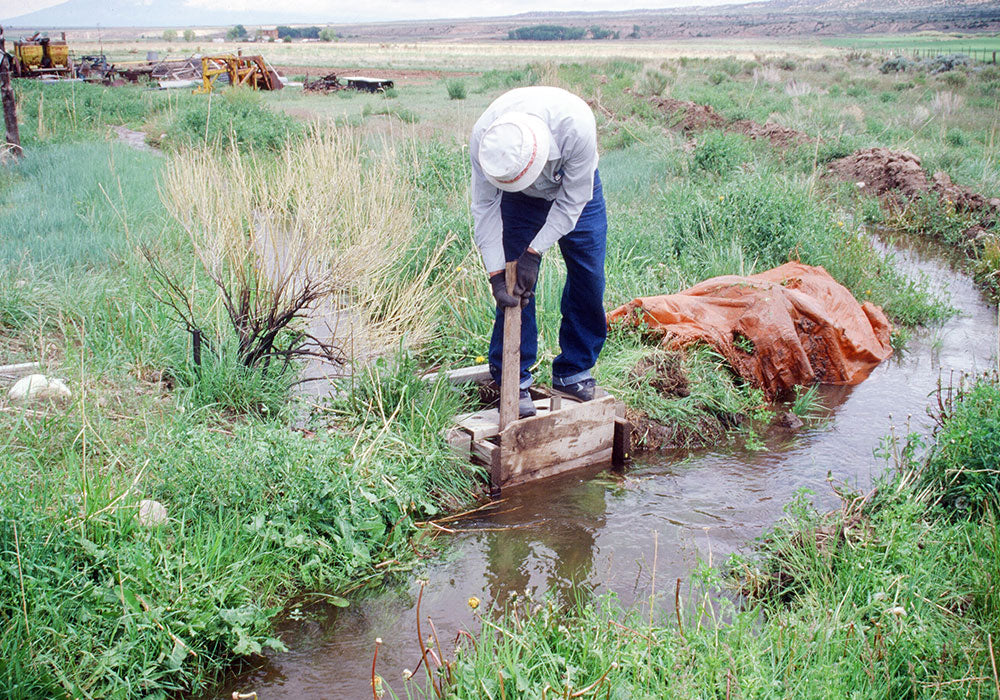 IMG >>> Farmer making repairs to his acequia water system in the San Luis Valley. Photo credit: San Jose State University
IMG >>> Farmer making repairs to his acequia water system in the San Luis Valley. Photo credit: San Jose State University
Local Ecosystems & Water Traditions
Just look at the centuries-old Limpieza tradition, where several Southern Colorado farmers get together to help clean up irrigation ditches each spring as the annual snowmelt arrives. Without the ritual and their unique communal water-sharing system (known as ancient trenches or flood canals called acequias), these dry areas would not be able to support life as we know it. In reflection of normal American "trap it, pipe it and pump it" mentalities to irrigate lands through out the country, acequias are based on the simplest of hydraulic genius – to use and share a river's natural patterns, far from a "new theory" but one we culturally need to address as water wars seem to be the new reality.
The famous migrating sandhill cranes depend on these water reserves as around 20,000 arrive in the spring and fall months, where they feed on barley in the fields and invertebrates that fill freshwater rivers and streams. Protecting such a beautiful rare bird that is the center of attention at one of the world’s biggest avian festivals is a privilege and duty. Local agriculture and the broader community are engaged and responsible for healthy waterways and food sources on which the cranes depend.
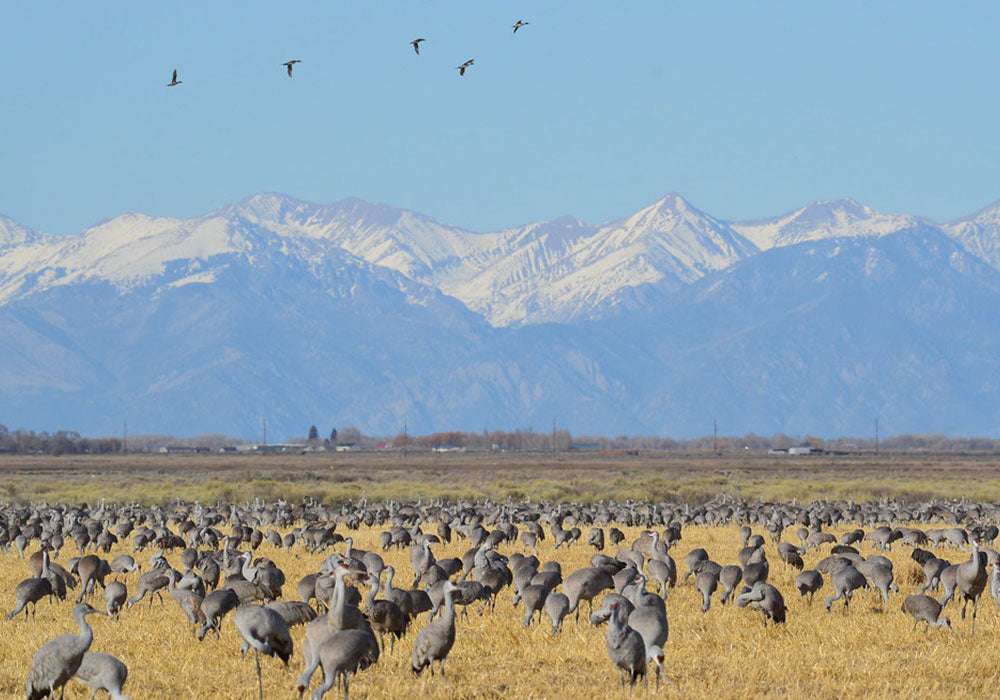 IMG >>> Migrating sandhill cranes near the Great Sand Dunes National Park. Photo credit: Patrick Myers via Flickr
IMG >>> Migrating sandhill cranes near the Great Sand Dunes National Park. Photo credit: Patrick Myers via Flickr
Today's inhabitants of the SLV can’t take Nature for granted due to the limited water rights and access in a rather dry, arid region most of the year. The San Luis Valley's aquifers sit at the headwaters of the mighty Rio Grande River and are always under assault from municipal interests. With the climate changing, these water battles and complex local ordinances make it mandatory that we explore fiber crops from a conservation perspective and request producers to engage in a restorative approach.
If you are aiming to grow and process hemp fiber in certain areas and you’re unable to irrigate properly, this may lead to regions being untenable to hemp genetics without drought tolerance adaptations. From the growing phase to the retting phase of hemp textile production, the water cycles and historical impediments, naturally occurring or influenced by legislative bodies in power, results in impacts that morph the physical characteristics of end products.
In terms of water, we all have to find better use practices and products to continue protecting this vital natural resource for all life and industry. Place matters, from the ground up, and all the way to your local statehouse.
Growing Fiber Hemp For Textiles
Buying fiber as a high-end finished textile brand is different than as a buyer purchasing batting fiber for grow mats or gardening bags (think coarse, jute fiber materials), or buying insulation for an engineering and home design firm. In the same way, for producers, there are many aspects that go into growing and preparing a fiber crop, beyond just the seed and soil. Right now it pays in hemp to know and target those buyers and end-user markets, even for secondary markets like selling hemp hurd for animal bedding.
Setting out to design and produce our own textile grade yarn with American-grown hemp meant that we had to ask ourselves, and our partners, a lot of questions beyond place. Any new, emerging field dictates a need for research and development. We have undertaken that R&D ourselves to produce better fiber and finished products year after year. While we forecasted our own best practices for partnerships in the growth and harvest cycle of this crop for commercial fiber applications, they are evolving with each season.
While the U.S. currently lacks fully operational hemp fiber processing infrastructure, including reliable commercial decortication, we see that a few technologies are close at hand and expect solutions to be available by the harvest of 2021.
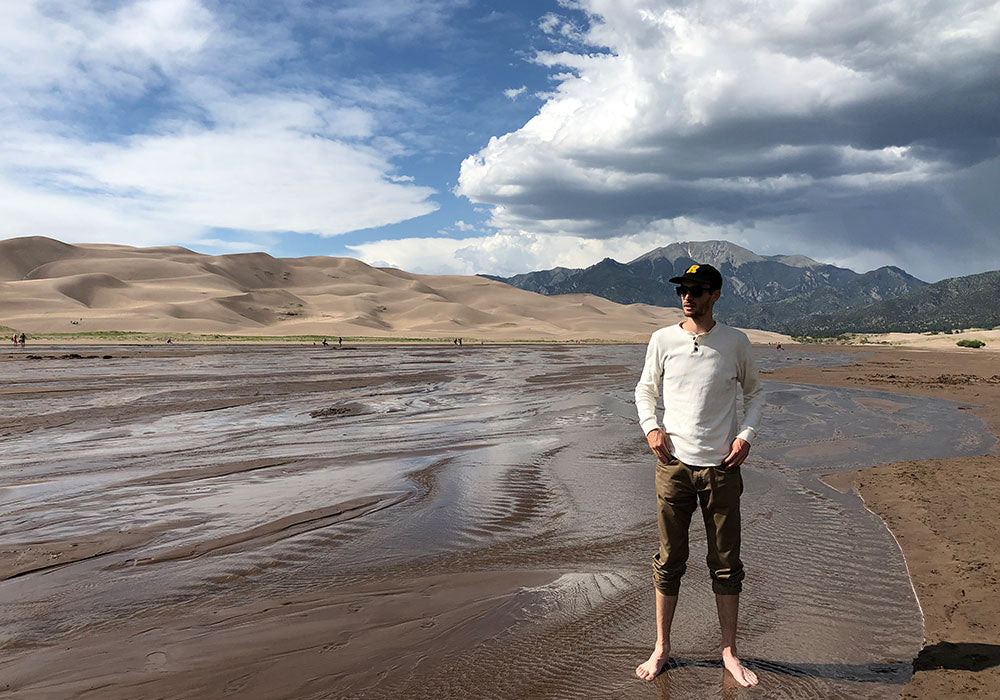 IMG >>> Recreator® team member JP amongst the hypnotic rivulet runoff pools that are entirely unique to the Great Sand Dunes National Park.
IMG >>> Recreator® team member JP amongst the hypnotic rivulet runoff pools that are entirely unique to the Great Sand Dunes National Park.
From our earlier brand collections and work in jersey and French terry knits, we hoped to recreate those same structures with American fibers one day. Initially targeting a “cottonized” hemp fiber that could be a suitable candidate for blending with cotton and spinning into a 20/1s yarn, cutting hemp fiber down to a short standardized fiber length is critical for the yarn spinning phase.
Because 'cotton is king' in America, our theory was that if we could find synergy in a staple cotton market, there would be hope for hemp. If a large cotton spinning mill would be willing to process and test our sample decorticated and degummed fibers, we hoped the process would continue with larger, more commercial orders and understanding of bast fiber-to-yarn productions.
We have tested and researched hemp varieties in climates other than the San Luis Valley – in trials with and without AOSCA-certified seed – there still remains debate around some of the blooming, harvesting and retting processes.
While the answers are hardly consistent, we recommend you seek guidance and resources from your regional and local agricultural universities and community colleges if possible. They should be able to help you with many technicalities of producing commercial and craft products from hemp fiber in your region.
If fiber is being produced at a technological capacity with greater uniformity, contracts can be pursued, however, we had (at time of this yarn production) yet to achieve any commercial capacity in this country. While decortication for first round Recreator yarn sampling was done two years ago, we have seen additional market infrastructures that could yield more adequate fiber for entering longer, larger market contracts.
 IMG >>> Recreator® hemp and organic cotton blended fiber being spun into yarn inside a U.S. facility in North Carolina. (Soil to Stitch TM)
IMG >>> Recreator® hemp and organic cotton blended fiber being spun into yarn inside a U.S. facility in North Carolina. (Soil to Stitch TM)
You may have heard of single-, dual- or tri-cropping – basically this is a form of categorization of finished product tiers based on usefulness and value from a single item. In a hemp crop, often the two most valued items are the cannabinoids and the seeds, leaving the stalk (fiber and hurd) as a “waste” product.
Although fine fiber crops are traditionally grown with a singular focus for the finished product, American farmers and producers seem to be targeting dual- and tri-crop producers as they have the most viable end markets right now. Hemp for finished textiles is a relatively complex system compared to decorticated hemp hurd for animal bedding. Both products may come from a single-, dual- or tri-crop, but the finished fiber will fall into different quality classifications.
When it comes to growing fiber plants, we saw seeding rates in early Colorado planting years between 25-40lbs per acre for seed production purposes, while it’s now recommended that number be at least 40-50 lbs per acre for finished fiber interests, with seed drilling at around 1 inch of depth like most row crops. Along with other proposed regenerative practices, traditional heavier seeding rates will allow the rapidly sprouting hemp crop to quickly develop a canopy that chokes out weeds and limits the commercial impulse for using toxic herbicides.
An acre of hemp could produce 6-10 tonnes of biomass, with 10-20% of textile grade fiber forecasted as it enters the critical processing phases. In our first trial run of cottonized hemp fiber, we had to produce at least 1000 lbs of prepared hemp fiber to enter sample blends with the cotton mill.
Although this amount of fiber wouldn't require much land, the processing complexities and our goals in the future are targeting 40 acre minimum productions for efficiencies in both processing and larger market partnerships. Our first fiber to trial in a cotton system yielded us a sample run of 600 lbs of hemp/cotton yarn at a rate of 20% hemp – 80% cotton, with much knowledge gained along the way in preserving our valuable fiber, and time, in the processing phases.
For most farmers around the country and down here in the Southern Colorado valley aiming at seed and fiber, they often plant towards the beginning of May through the first week of June. Intermittent irrigation is often required for this region, especially early in the season as roots and cover form before the striking sun torches the soil thru June and July with increased summer temperatures. From flood to center pivot, there remains a lot of testing to be done depending on your location, and seasonal attitudes.
Around the sixth week, you should begin to notice male flowering. From there it’s only about seven to eight more weeks until the plants will be ready for harvesting and early-stage processing depending on contracted products. Similar to flax, hemp fiber has a 100-day growing season on average.
 IMG >>> Hemp fiber stalks growing in Springfield, Colorado at Loflin Farms. Photo credit: Recreator®
IMG >>> Hemp fiber stalks growing in Springfield, Colorado at Loflin Farms. Photo credit: Recreator®
Hemp stalks grow tall and quite quickly, with some cultivars reaching fifteen feet – the incredibly long and durable fiber gives hemp a very important set of industrial characteristics in comparison to cotton or synthetic materials like rayon and polyester. It also adds to the ability of hemp to produce far higher yields in terms of overall biomass compared to other fiber crops once scaled up.
This early in the maturation of the hemp market, we recommend farmers work through R&D for a few years by rotating hemp in with other crop cycles and while exploring different growing techniques (cover cropping, no-till farming, livestock rotations, etc.).
Bear in mind, genetics developed in California may not be suitable to grow high-grade hemp products in Midwestern or East Coast climates. If looking for profits, only plant large acreage if you have worked through official contracts from seed to fiber buyers – don't plant seed this month expecting any purchasing angel to arrive come harvest season.
Hemp Fiber Harvesting
A sequence of operations with the ultimate purpose of separating the fibers from the rest of the plant are important even when harvesting. Specific to bast fibers, there seems potential and reason to harvest both before and after pollination, depending on many factors.
In traditional textile productions with hemp, harvesting was done by hand, sometimes cut (w/ scythe) above the roots/soil and sometimes pulled from the roots, leaving the entire plant intact. Most cultures that worked in hemp utilized every part of the plant, even the root (although in therapeutic applications) and seed, meaning open pollination was king to produce the family’s superfood, fiber and medicines.
While modernized harvesting equipment has proven promise in the advancing bast markets in other countries, there remains a nascent American market evolution. Our best research material initially (in 2018) was harvested as a seed crop from a 25-30 lb/acre planting density. This means the seed was combined off and a second pass reduced the stalks to the ground, where the retting process began.
Hemp Fiber Retting - Dew and/or Water
While most of America's fields are filled with CBD-rich or food-end market potentials with seed and oils, there remains a lot of fiber assessed posthumously, wasted. Retting becomes a relatively foreign term. However, in hemp for fiber applications, retting is a critical process to aid in separating stalk components to "spin-able" textile yarn.
While an art in itself, retting is a technical term applied to the biological breakdown of organic material to aid in its later processing function. Retting happens mostly between harvest and bailing. Continuous movement in the retting process, both in bacterial workings and field applications, seems to aid in the critical processing steps ahead that will achieve the finest textile-grade hemp fiber from, and for, American soils.
Towing the line between a rotted crop in your field and a suitable time for this crop to be bailed (typically 2-4 weeks) before the next processing point, proper retting has variables that are not easily generalized or recreated by man. How specific environments degrade crops, and even the benefits of utilizing retting as a soil-restorative practice, deserves more attention as it deeply impacts the next, and ultimately final thread to our hemp fabric, America's fiber futures and downstream impacts.
In many stages of the fiber process, from growing to the spinning of a yarn product of any natural fiber, moisture and humidity levels can be both friend and foe. Evaluating retting, and overall humidity, at this stage in the hemp stalk’s journey will give all the signals to timing the bailing before sending it to a mill. Expertise in evaluating curing conditions and storing procedures will further add to a superior raw fiber end product.
In the variety of regions in which we assessed fiber being grown, we found the San Luis Valley ecosystem a special mix of conditions that provided us with a good “cottonizable” fiber that year. These natural conditions and finding visible changes in the stalks’ fibers as they continue the separation process is hard to reproduce.
Many claim to advance natural fiber progress with chemistry and “degumming” in other commercial hopes to a spinnable product, but the proof will always be in the researched results. In years ahead, we hope Recreator fiber won’t need additional degumming or any caustic solution-based bathing to speed up or advance what nature can do for us.
If a field has proper retting variables and keen producers, moisture levels are critically understood between the next step where the fiber goes into a bale to be stored, or to be sent to a mill to further processing. While bast fiber – especially in areas where moisture and humidity levels are low – can be stored for years before end processing, there should be intention in limiting storage needs to be within range of ideal moisture conditions for confidence in sending through any processing equipment without either breaking it, or yielding a product that needs further refinement.
In the next edition of How to Make It In America, it's on to processing and treatments for textile-grade hemp fiber.
READINGS & RESOURCES
REC Blog: Traditional Method of Hemp Textile Production
REC Blog: New Visions for Hemp & Medicine in America
FIBERSHED: Colorado Hemp Research Project
History – Utah.gov // San Luis Valley


 IMG >>> Recreator® raw hemp and organic fibers alongside a Colorado hemp seed variety.
IMG >>> Recreator® raw hemp and organic fibers alongside a Colorado hemp seed variety. IMG >>> Recreator® photo taken in a Springfield, Colorado field nearby the history-making hemp farm at Loflin Farms, operated by farmer Ryan Loflin.
IMG >>> Recreator® photo taken in a Springfield, Colorado field nearby the history-making hemp farm at Loflin Farms, operated by farmer Ryan Loflin. IMG >>> 3D printed hemp plastic production piece from early 2015 using 100% American hemp, partnering with local manufacturers of 3D printers in Loveland, Colorado with hemp grown by New West Genetics in 2015.
IMG >>> 3D printed hemp plastic production piece from early 2015 using 100% American hemp, partnering with local manufacturers of 3D printers in Loveland, Colorado with hemp grown by New West Genetics in 2015. IMG >>> Recreator® Yarn Project – Yarn produced with a fine blend of American-grown hemp and cotton fibers. ( Soil to Stitch TM )
IMG >>> Recreator® Yarn Project – Yarn produced with a fine blend of American-grown hemp and cotton fibers. ( Soil to Stitch TM ) IMG >>> Aerial shot of the San Luis Valley, Colorado. Photo credit: Pavliha (iStock)
IMG >>> Aerial shot of the San Luis Valley, Colorado. Photo credit: Pavliha (iStock) IMG >>> Farmer making repairs to his acequia water system in the San Luis Valley. Photo credit: San Jose State University
IMG >>> Farmer making repairs to his acequia water system in the San Luis Valley. Photo credit: San Jose State University  IMG >>> Migrating sandhill cranes near the Great Sand Dunes National Park. Photo credit: Patrick Myers via
IMG >>> Migrating sandhill cranes near the Great Sand Dunes National Park. Photo credit: Patrick Myers via  IMG >>> Recreator® team member JP amongst the hypnotic rivulet runoff pools that are entirely unique to the Great Sand Dunes National Park.
IMG >>> Recreator® team member JP amongst the hypnotic rivulet runoff pools that are entirely unique to the Great Sand Dunes National Park. IMG >>> Recreator® hemp and organic cotton blended fiber being spun into yarn inside a U.S. facility in North Carolina. (Soil to Stitch TM)
IMG >>> Recreator® hemp and organic cotton blended fiber being spun into yarn inside a U.S. facility in North Carolina. (Soil to Stitch TM) IMG >>> Hemp fiber stalks growing in Springfield, Colorado at Loflin Farms. Photo credit: Recreator®
IMG >>> Hemp fiber stalks growing in Springfield, Colorado at Loflin Farms. Photo credit: Recreator®


